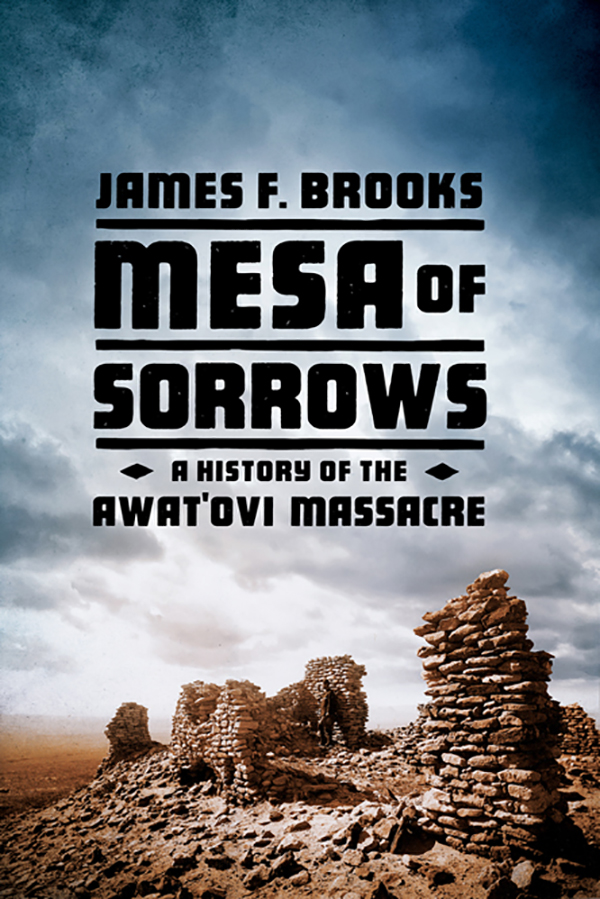
Mesa of Sorrows
A History of the Awat'ovi Massacre
کتاب های مرتبط
- اطلاعات
- نقد و بررسی
- دیدگاه کاربران
نقد و بررسی

December 14, 2015
In this vivid work of ethno-history, Brooks (Captives and Cousins) brings to life the Hopi Indian community of Awat’ovi, on Arizona’s Antelope Mesa. In the spring of 1700, Awat’ovi was destroyed and most of its inhabitants were killed. The attackers were fellow Hopi; as Brooks deftly shows, the offending group felt that Awat’ovi had fallen into koyaanisqatsi (moral corruption and chaos). The social order could only be restored by the village’s complete obliteration, with the ruins left to function as an “evil place” in local memory. Brooks works from historical and archaeological sources, revealing Awat’ovi’s long history as a place associated with sorcery. He emphasizes that the arrival of Franciscan missionaries in 1629, and their ejection in the course of Po’pay’s Rebellion in 1680, ensured that “something powerful remained” to trouble the land. Hopi identity was centered on individual villages, and each town’s inhabitants did not view those from other towns as their people. When Spanish friars returned to Awat’ovi, generating tensions between Catholic converts and practitioners of traditional religion, the warriors of the nearby Walpi and Oraibi communities were willing to respond to an Awat’ovi leader’s appeal and destroy the impure community. Brooks tells this tragic story with great sensitivity and power, offering readers a fascinating perspective on the history of the American Southwest. Agency: Garamond Agency.

November 1, 2015
Rather than a tale of bloody carnage, Brooks (History and Anthropology/Univ. of California, Santa Barbara; Captives and Cousins: Slavery, Kinship, and Community in the Southwest Borderlands, 2002) delivers a sharp scholarly account of the Hopi and their history, myths, and traditions.The story of the Awat'ovi massacre on Antelope Mesa in 1700 stands out as perhaps the most traumatic event in Hopi history, shaping the history of the "Peaceful People." However, apparently they were not all that peaceful; the massacre occurred because of a fissure between those who converted to Catholicism at the hands of the Franciscans' coercion and studied violence and those who clung to the old ways. While the author states that the event is well-remembered, it is also one the Hopi would rather forget. It is the embodiment of the Pahanna prophecy, a dialectic of destruction and resurrection. The leader of the Awat'ovi, Ta'polo, despaired for those who were rejecting the traditional rites, quarreling, robbing their neighbors, raping, and stealing. Ta'polo convinced the neighboring Walpi and Oraibi to attack and destroy the pueblo, opening the gate and allowing them in. The massacre, however, was not the first self-inflicted in the Hopi nation. The Hopi did not consider themselves as belonging to the same tribe; their village was their nationality--e.g., they were Walpi before Hopi. The long history of the Hopi includes other instances of this purification through obliteration. The purpose was to wash away corruption, bring renewal, and restore balance. In the event of obliteration, there was no looting; in fact, after the massacre, no Hopi would claim the land since it was an evil place. The narratives the author provides about the Hopi, some of which may be more about a time than a place, reveal the fascinating complexity of this early civilization. An occasionally repetitive but fully illuminating account for any who relish the rich history and traditions of the Hopi.
COPYRIGHT(2015) Kirkus Reviews, ALL RIGHTS RESERVED.

October 1, 2015
In 1700, Awat'ovi, a peaceful Hopi community on Arizona's Antelope Mesa, was set upon by neighboring Hopi Indians and its inhabitants brutally slain. Brooks, professor of history and anthropology at the University of California, Santa Barbara, and the author of "Captives and Cousins", which received the Bancroft, Francis Parkman, and Frederick Douglass prizes, untangles what has since been a painful mystery.
Copyright 2015 Library Journal, LLC Used with permission.

























دیدگاه کاربران